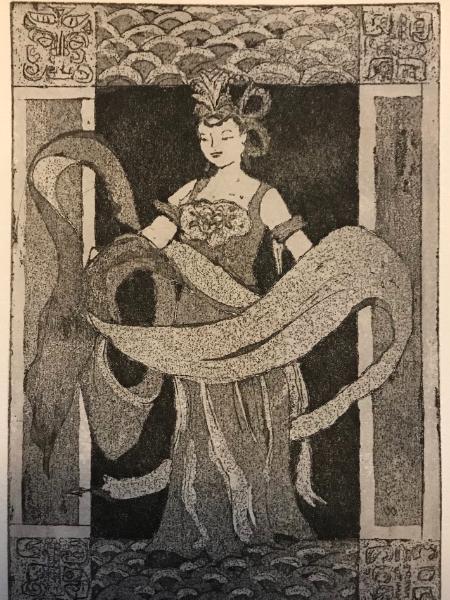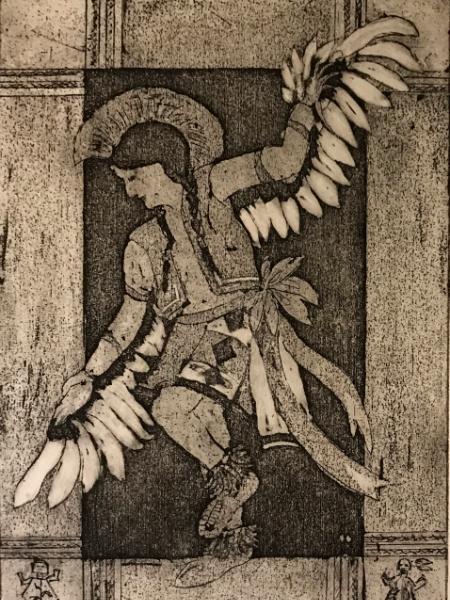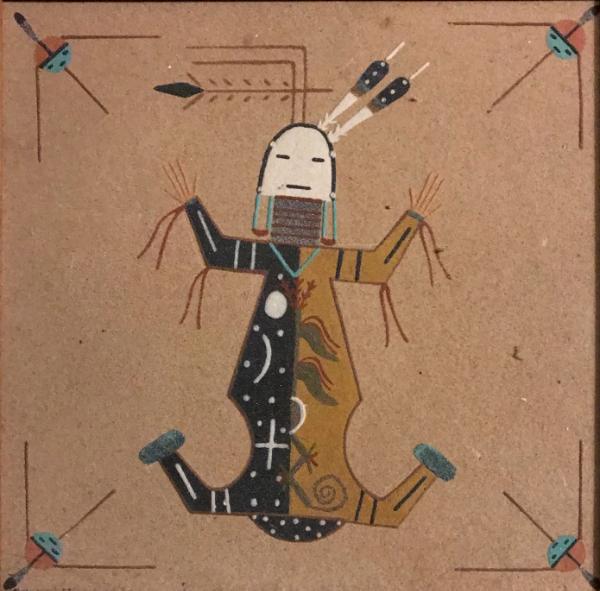| 9/4/21 |
Country/People: Chinese (Tang dynasty) Dance: Palace White Linen Dance Border Porcelain ceramic pattern, T’ao Ti’eh corners 你好[ nǐhǎo ]Hello Dance: The Tang Dynasty (618-907) was a period of peace and high culture and is considered China’s Golden Age. In this period, the academy for poets was founded, and nearly 50,000 poems were written and preserved. Woodblock printing was established, which helped the spread of Buddhism, and Buddhist Festivals became popular. Music and Dance were part of courtly activities, and Chinese Painting developed and advanced, thanks to the patronage of the imperial court. One of the dances performed for the emperor was the “White Linen” dance (白紵舞), in which the female dancers gracefully move long, extensions of their sleeves in circular motions, meant to resemble clouds chasing the moon. Although the dance existed as far back as the Jin dynasty (265-316), it reached its peak during the Tang dynasty. I was fortunate to see a performance of Tang Emperor dances and music while in Xi’an in 2005, and this dance was by far the most elegant and graceful. Attire: During the Tang dynasty, times were not only prosperous and peaceful, but also in some ways liberating, at least as far as fashion was involved. Looser silk dresses, longer wing-like sleeves and even low-cut gowns were popular. Hair styles usually covered the temples, but had a bun and braid loops in a variety of styles, such as the one on our figure. Silk fabric weaving also flourished during this period. Sericulture or silk weaving had been part of Chinese culture for thousands of years, but during the Tang dynasty there were eight different types of silk fabrics, classified by their particular weaves, such as gauzes, damasks, brocades, crepes, and tapestries. (Silk was a precious commodity and traded for horses on the Silk Road.) While the dresses of the dancers may have been silk, the ribbon-like sleeves were made from a “bast” fiber, (hemp, ramie or kudzu), classified as linen. Border: The top and bottom mid sections of the border are inspired by Chinese porcelain patterns. Porcelain was probably “discovered” during the Tang dynasty, but production really flourished in later dynasties, reaching peak periods during the Ming dynasty (1368-1644) and Qing dynasty (1644-1912). The addition of kaolin, a soft, white clay material and firing the ceramics at a very high temperature are what gives porcelain pieces their distinctive, translucent look. For a long time, the formula was a prized secret of the Chinese. (That is why this fine ceramic ware is often called “China” in other countries.) The corner images are t’ao-t’ieh figures found on bronze vessels from the much earlier Shang Dynasty (ca. 1600–1046 B.C.E.). The Shang t'ao-t'ieh image exists around a pair of circles or ovals placed near enough to each other to intimate eyes. It is the presence of these eyes that gives the t'ao-t'ieh its life and creates in it an entity, albeit an incomplete one. Since the ability to produce a representational figure existed during the Shang dynasty, the lack of such representational form in the t'ao-t'ieh images suggests a purposeful omission. I suspect that the t'ao-t'ieh depicts a spirit or supernatural deity whose form is unknown, but whose being is incorporated into the bronze.
References and Links History of Porcelainhttps://www.artistictile.net/store/info-history-of-porcelain.htmlSong, Candice. 9.3.2021. The Tang Dynasty Showhttps://www.chinahighlights.com/xian/attraction/tang-dynasty-show.htm Traditional clothing of Chinese dynasties: from Xia and Shang Dynasties to Tang Dynasty http://nationalclothing.org/asia/39-china/352-traditional-clothing-of-chinese-dynasties-from-xia-and-shang-dynasties-to-tang-dynasty.html The Tang Dynasty in China: A Golden Era Asian Traditional Theatre & Dance. https://disco.teak.fi/asia/the-tang-dynasty-618-907/ |
Be the first to post a comment.
|
9/1/21 |
Country/ People: U.S.A. Native Americans Dance: Eagle Dance, Cherokee (and others) Border: Navajo Sand paintings
Osiyo Hello (in Cherokee)
The Eagle Dance has been performed by many Native American tribes or nations including the Iroquois, Comanche, Calumet, Cree and Cherokee. Today, it is often part of celebrations of the Jemez and Tesuque tribes of New Mexico. The eagle holds a special place in Indian cultures, representing wisdom and strength. Some groups believed the Eagle held supernatural powers that allowed it to transport prayers to the gods. The dancer, adorned with feathers strapped to his arms like wings, imitated the movements and activities of the eagle. Using only white (or nearly white) eagle feathers, false wings up to six feet long are created for the dancer to wear across his shoulders and arms. (Native Americans have been granted special privileges to collect and use these feathers, generally illegal under the Bald Eagle Protection Act of 1940, for ceremonial purpose.) These ceremonial eagle wings not only represent the majestic bird but add drama and accentuate movements in the dance. At times in our history, the use of feathers in ceremonial dances and religious rites was used as an excuse to forbid traditional dances and practices by Native American. An interesting article that discusses this topic was published in 1991. (N. Brown, .Donald "Indians, Feathers, and the Law in Western Oklahoma" Expedition Magazine 33.2 (1991): n. pag. Expedition Magazine. Penn Museum, 1991 Web. 03 Feb 2021 http://www.penn.museum/sites/expedition/?p=3960) The Eagle Dancer wears soft, leather moccasins, shoes worn my most Native Americans. There were individual style and different ornamentations, but the basic concept remained across Native nations. Often made of deerskin, they allowed the wearer to move quietly and feel the ground, but protected him/her from thrones and other impediments. Border: On the four corners of the border, I have indicated sand paintings. Sand paintings were another way that some Native Americans believe they can communicate with the spirits. These are colorful, beautifully designed works of art. Although the Native Americans who originally created them did not consider them art, but rather prayer and medicine. As the name suggests, they were created of sand, with colors dyed from natural materials such as crushed stone, pollen and flowers. And they were also created in the sand as part of a healing ceremony. Once completed and sanctified, the person in need of healing sits in the middle of the image so that the spirits represented can realign the “patient” with the earth. Once the ceremony and prayers were completed, the image could be destroyed, brushed away to bring its message to the gods. In addition to the Navajo, the Hopi and Zuni Indians of the American southwest, create these ethereal paintings. The Navajo call sand painting 'iikááh, "place where the gods come and go." However, as time has moved on, many of the sand painting designs have been created on permanent surfaces (sandpaper coated) for sale as art to tourists, which helps the native economy. I modeled the four images here after sand paintings I purchased decades ago to add to my cultural collection. Some of the common symbols with stylized, geometric shaped bodies include Father Sky and Mother Earth (Taos Pueblo* UNESCO )
References: Dockstrader, Frederick J. Indian Art of the Americas, Museum of the American Indian.1973 print Eagle Dance - Unto These Hills, Cherokee, NC 201 Video. https://www.youtube.com/watch?v=JyXUvd7F0kE Native People.org Navajo SandpaintingsNationalclothing.org Native American Indian moccasins and their marvelous embellishments 10/10/2019  |
Be the first to post a comment.
|
Previously published:All 24 blog entries The Art and Writing of Barbara Rizza Mellin RSS |  |
|